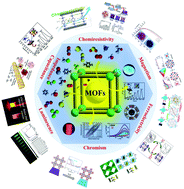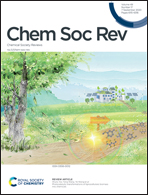Functional metal–organic frameworks as effective sensors of gases and volatile compounds
Abstract
Developing efficient sensor materials with superior performance for selective, fast and sensitive detection of gases and volatile organic compounds (VOCs) is essential for human health and environmental protection, through monitoring indoor and outdoor air pollutions, managing industrial processes, controlling food quality and assisting early diagnosis of diseases. Metal–organic frameworks (MOFs) are a unique type of crystalline and porous solid material constructed from metal nodes (metal ions or clusters) and functional organic ligands. They have been investigated extensively for possible use as high performance sensors for the detection of many different gases and VOCs in recent years, due to their large surface area, tunable pore size, functionalizable sites and intriguing properties, such as electrical conductivity, magnetism, ferroelectricity, luminescence and chromism. The high porosity of MOFs allows them to interact strongly with various analytes, including gases and VOCs, thus resulting in easily measurable responses to different physicochemical parameters. Although much of the recent work on MOF-based luminescent sensors have been summarized in several excellent reviews (up to 2018), a comprehensive overview of these materials for sensing gases and VOCs based on chemiresistive, magnetic, ferroelectric, and colorimertic mechanisms is missing. In this review, we highlight the most recent progress in developing MOF sensing and switching materials with an emphasis on sensing mechanisms based on electricity, magnetism, ferroelectricity and chromism. We provide a comprehensive analysis on the MOF–analyte interactions in these processes, which play a key role in the sensing performance of the MOF-based sensors and switches. We discuss in detail possible applications of MOF-based sensing and switching materials in detecting oxygen, water vapor, toxic industrial gases (such as hydrogen sulfide, ammonia, sulfur dioxide, nitrous oxide, carbon oxides and carbon disulfide) and VOCs (such as aromatic and aliphatic hydrocarbons, ketones, alcohols, aldehydes, chlorinated hydrocarbons and N,N′-dimethylformamide). Overall, this review serves as a timely source of information and provides insight for the future development of advanced MOF materials as next-generation gas and VOC sensors.



 Please wait while we load your content...
Please wait while we load your content...